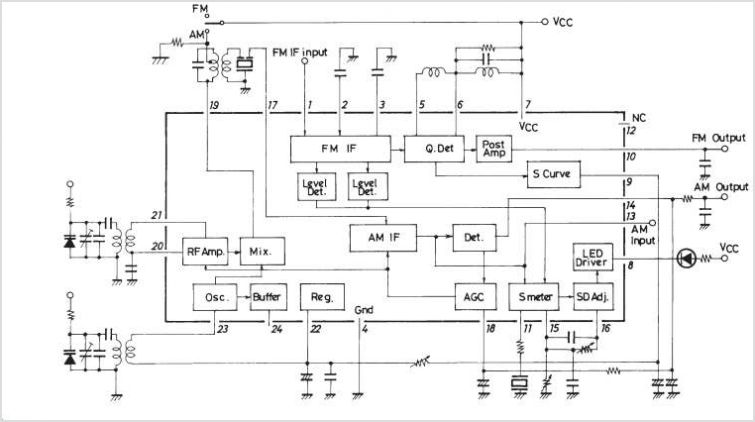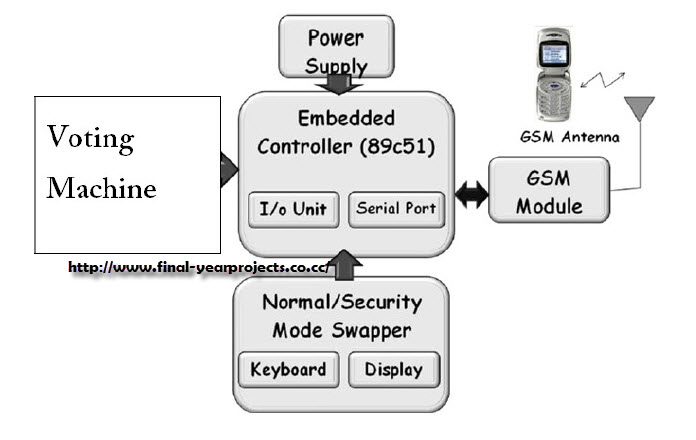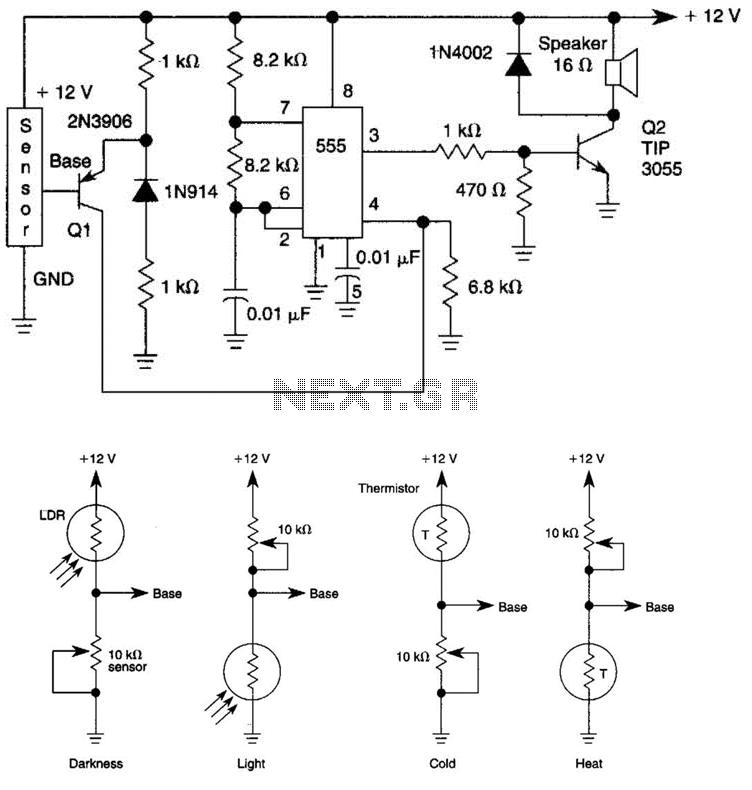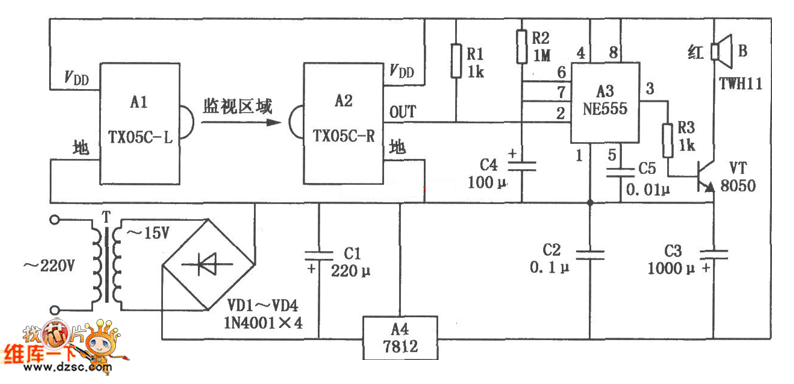
6 Zone Alarm System

This alarm system features six independent zones, one timed entry/exit zone, a seven-segment LED display, and a test or walkthrough capability. It is designed for use in small office or home environments and can be adapted to utilize a combination lock or keypad for setting and resetting the alarm. All orange +V terminals should connect to the point marked +5V at the side of the set switch, S1. Integrated circuits U1, U2, U3, U4, U5, and U7 are depicted without power connections for clarity; these connections must be connected to +5V and ground. Refer to the Practical Section for IC pinouts and relay contacts. Zones Z1 to Z6 utilize normally closed alarm contacts, with Zone 1 designated as a timed zone, serving as the entry and exit point of the building. Zones 2 to 6 are immediate zones that will trigger the alarm without delay. Input capacitors C1 to C6 provide some RF immunity for long wiring runs. The key switch, S1, functions as the Set and Reset/Unset switch; for optimal security, a metal type switch with a key is recommended. All integrated circuits, except for IC6, are CMOS types with buffered outputs, indicated by the suffix "B." Unbuffered CMOS ICs, denoted by a suffix starting with "U," are incompatible with this circuit. IC6 serves as a 5 Volt regulator supplying power to the main CMOS ICs, and the alarm power supply can be any suitable 12 to 15V source. In operation, the DPDT switch S2 is placed in the "run" position. When keyswitch S1 is turned to reset, this indicates the unset (off) state of the alarm. In this state, capacitor C8 discharges through D9, R1, and Z1, while capacitor C7 discharges through D8, R17, and S1. Relay RLY1 remains de-energized, and all CMOS ICs and the display receive no power. When S1 is set, all CMOS ICs are powered with 5 Volts. Capacitor C11 briefly charges, providing a low input signal to one half of U7A, a CMOS4001B dual input OR gate. The output of U5A will also be low (ensuring that all windows and doors in zones 2 to 5 are closed), while the output of U7A becomes high. The output from U7A is inverted by U7B and fed back via R18 to maintain the latch. The output of U7B remains low, resulting in Q1 and relay RLY1 being off, hence no alarm is triggered. Additionally, when S1 is set, C8 charges slowly through R13, forming an exit timer that allows time to vacate the premises. The delay is approximately 1.1 times the value of C8 (in μF), equating to about 52 seconds with the specified values. During the exit delay, zone switch Z1 can be opened and closed without activating the alarm. Upon the expiration of the exit time, C8 is charged, causing one half of the 2-input AND gate, U4A, to go high. Any opening of zones 2 through 6 will trigger the alarm and energize relay RLY1. For instance, if an intruder attempts to breach zone 4, the output of U1D will transition from low to high. This high signal is relayed by U2C, a triple input OR gate (CMOS4075), to input C of the CMOS4511 BCD to Decimal display driver. The binary representation for four is 100, with input C high, while A and B remain low, illuminating digit 4 on the LED display. The high output from U2C is also sent to U5A, another triple input OR gate. The output from U5A is directed via S2 to the input of U7A. U7A and U7B function as a bistable latch, with the change in state causing the output of U7A to become low and the output of U7B to become high, which is fed back to U7A's input. The circuit is now latched in a high state. The high output of U7B activates Q1 and relay RLY1, sounding the alarm. Additionally, the high output at U7B is applied to the blanking input of the CMOS4511B via S2 and the enable latching pin. The display will continuously indicate the number of the triggered zone, even if the zone switch is subsequently opened or closed. This process is similarly applied to any of the other immediate zones. As the alarm system utilizes six zones, the CMOS4511 BCD to decimal decoder must accommodate counting to six, which corresponds to 110 in binary. Thus, only inputs A, B, and C are utilized.
The alarm system is designed to provide comprehensive security coverage across multiple zones, ensuring immediate detection of unauthorized access while allowing for a timed exit period. The integration of CMOS technology enhances reliability and power efficiency, making it suitable for various applications in residential and small commercial settings. The use of a seven-segment display facilitates user interaction by clearly indicating the status of the alarm and which zone has been triggered, thus enhancing the overall functionality of the system. The design consideration for RF immunity through the use of input capacitors further ensures the robustness of the alarm system, minimizing false alarms that could arise from electrical interference. The implementation of a metal key switch for setting and resetting the alarm adds a layer of physical security, preventing unauthorized access to the alarm controls. This alarm system exemplifies a well-engineered solution for effective perimeter security in environments where rapid response to unauthorized entry is critical.This alarm system has 6 independent zones, 1 timed entry/exit zone, a 7 segment LED display and a test or walkthrough facility. Suitable for a small office or home environment, it can also be adapted to use a combination lock or keypad to set and reset the alarm.
Please Note: All orange +V terminals connect to the point marked +5V at the side of t he set switch, S1. IC`s U1, U2, U3, U4, U5 and U7 are drawn without power connections for clarity. The power connections need to go +5V and ground. See Practical Section for IC pinouts and relay contacts. All zones Z1 to Z6 use normally closed alarm contacts. Zone 1 is a timed zone which must be used as the entry and exit point of the building. Zones 2 to 6 are immediate zones, which will trigger the alarm with no delay. Some RF immunity is provided for long wiring runs by the input capacitors, C1 - C6. The key switch, S1 acts as the Set and Reset/Unset switch. For best security this should be the metal type switch with a key. All IC`s except IC6 are CMOS types with buffered outputs, these are denoted by the suffix "B". Unbuffered CMOS IC`s have a suffix starting "U" and will not work in this circuit. IC6 is a 5 Volt regulator providing power to the main CMOS IC`s, the alarm power supply can be any suitable 12 to 15V power supply. In operation the DPDT switch S2 is set to the "run" position. When keyswitch S1 is turned reset, this is the unset (off) state of the alarm. In this condition capacitor C8 will discharge via D9, R1 and Z1 and capacitor C7 will have discharged via D8, R17 and S1.
Relay RLY1 will not be energized and all CMOS IC`s and the display will have no power. When S1 is turned to set all CMOS IC`s receive 5 Volt power. C11 will briefly charge and apply a low input signal to one half of U7A a CMOS4001B, a dual input OR gate. The output of U5A will also be low (make sure all windows and doors zones 2 to 5 are shut) and the output of U7A is high.
The output of U7A is then inverted by U7B and fed back via R18 to U7A`s input keeping the circuit latched. The output of U7B is low and so Q1 and the relay RLY1 is off and no alarm will sound. Also when S1 is set, C8 slowly charges via R13. C8 and R13 form the exit timer and allow time to vacate the building. The delay is approximately 1. 1 x the value of C8 (in uF) or about 52 seconds with values shown. During the exit delay zone switch Z1 can be opened and closed without triggering the alarm. After the exit time ends, C8 will be charged and one half of the 2 input AND gate, U4A will now be high.
Any opening of zones 2 through 6 will cause the alarm to trigger and relay RLY1 will energize. If an intruder attempts a break-in via zone 4 for example, the output of U1D will change state from low to high. When this happens, the high signal is forwarded by U2C a triple input OR gate CMOS4075 and is sent to input C on the CMOS4511 BCD to Decimal display driver.
The binary code for four is 100 and input C is high, A abd B are low, and the LED display will illuminate digit 4. The high output from U2C is also forwarded to U5A, again a triple input OR gate. The output of U5A is now sent via S2 to the input of U7A. U7A and U7B form a bistable latch, the change in state causing the output of U7A to change to low, the output of U7B to become high and fed back via R18 to the input of U7A again.
The circuit is now latched in the high state. The high output of U7B does two things. First it switches on Q1 and relay RLY1 sounding the alarm. Secondly the high output at U7B is applied to the blanking input of the CMOS4511B via S2 and also to the enable latching pin. The display will now continually show the number of the triggered zone, even if the zone switch is opened or closed again.
It is a similar process for any of the other immediate zones. As this alarm uses 6 zones, the CMOS 4511 BCD to decimal decoder must count to 6 which is 110 in binary. Therefore only inputs A, B and C are 🔗 External reference
The alarm system is designed to provide comprehensive security coverage across multiple zones, ensuring immediate detection of unauthorized access while allowing for a timed exit period. The integration of CMOS technology enhances reliability and power efficiency, making it suitable for various applications in residential and small commercial settings. The use of a seven-segment display facilitates user interaction by clearly indicating the status of the alarm and which zone has been triggered, thus enhancing the overall functionality of the system. The design consideration for RF immunity through the use of input capacitors further ensures the robustness of the alarm system, minimizing false alarms that could arise from electrical interference. The implementation of a metal key switch for setting and resetting the alarm adds a layer of physical security, preventing unauthorized access to the alarm controls. This alarm system exemplifies a well-engineered solution for effective perimeter security in environments where rapid response to unauthorized entry is critical.This alarm system has 6 independent zones, 1 timed entry/exit zone, a 7 segment LED display and a test or walkthrough facility. Suitable for a small office or home environment, it can also be adapted to use a combination lock or keypad to set and reset the alarm.
Please Note: All orange +V terminals connect to the point marked +5V at the side of t he set switch, S1. IC`s U1, U2, U3, U4, U5 and U7 are drawn without power connections for clarity. The power connections need to go +5V and ground. See Practical Section for IC pinouts and relay contacts. All zones Z1 to Z6 use normally closed alarm contacts. Zone 1 is a timed zone which must be used as the entry and exit point of the building. Zones 2 to 6 are immediate zones, which will trigger the alarm with no delay. Some RF immunity is provided for long wiring runs by the input capacitors, C1 - C6. The key switch, S1 acts as the Set and Reset/Unset switch. For best security this should be the metal type switch with a key. All IC`s except IC6 are CMOS types with buffered outputs, these are denoted by the suffix "B". Unbuffered CMOS IC`s have a suffix starting "U" and will not work in this circuit. IC6 is a 5 Volt regulator providing power to the main CMOS IC`s, the alarm power supply can be any suitable 12 to 15V power supply. In operation the DPDT switch S2 is set to the "run" position. When keyswitch S1 is turned reset, this is the unset (off) state of the alarm. In this condition capacitor C8 will discharge via D9, R1 and Z1 and capacitor C7 will have discharged via D8, R17 and S1.
Relay RLY1 will not be energized and all CMOS IC`s and the display will have no power. When S1 is turned to set all CMOS IC`s receive 5 Volt power. C11 will briefly charge and apply a low input signal to one half of U7A a CMOS4001B, a dual input OR gate. The output of U5A will also be low (make sure all windows and doors zones 2 to 5 are shut) and the output of U7A is high.
The output of U7A is then inverted by U7B and fed back via R18 to U7A`s input keeping the circuit latched. The output of U7B is low and so Q1 and the relay RLY1 is off and no alarm will sound. Also when S1 is set, C8 slowly charges via R13. C8 and R13 form the exit timer and allow time to vacate the building. The delay is approximately 1. 1 x the value of C8 (in uF) or about 52 seconds with values shown. During the exit delay zone switch Z1 can be opened and closed without triggering the alarm. After the exit time ends, C8 will be charged and one half of the 2 input AND gate, U4A will now be high.
Any opening of zones 2 through 6 will cause the alarm to trigger and relay RLY1 will energize. If an intruder attempts a break-in via zone 4 for example, the output of U1D will change state from low to high. When this happens, the high signal is forwarded by U2C a triple input OR gate CMOS4075 and is sent to input C on the CMOS4511 BCD to Decimal display driver.
The binary code for four is 100 and input C is high, A abd B are low, and the LED display will illuminate digit 4. The high output from U2C is also forwarded to U5A, again a triple input OR gate. The output of U5A is now sent via S2 to the input of U7A. U7A and U7B form a bistable latch, the change in state causing the output of U7A to change to low, the output of U7B to become high and fed back via R18 to the input of U7A again.
The circuit is now latched in the high state. The high output of U7B does two things. First it switches on Q1 and relay RLY1 sounding the alarm. Secondly the high output at U7B is applied to the blanking input of the CMOS4511B via S2 and also to the enable latching pin. The display will now continually show the number of the triggered zone, even if the zone switch is opened or closed again.
It is a similar process for any of the other immediate zones. As this alarm uses 6 zones, the CMOS 4511 BCD to decimal decoder must count to 6 which is 110 in binary. Therefore only inputs A, B and C are 🔗 External reference





